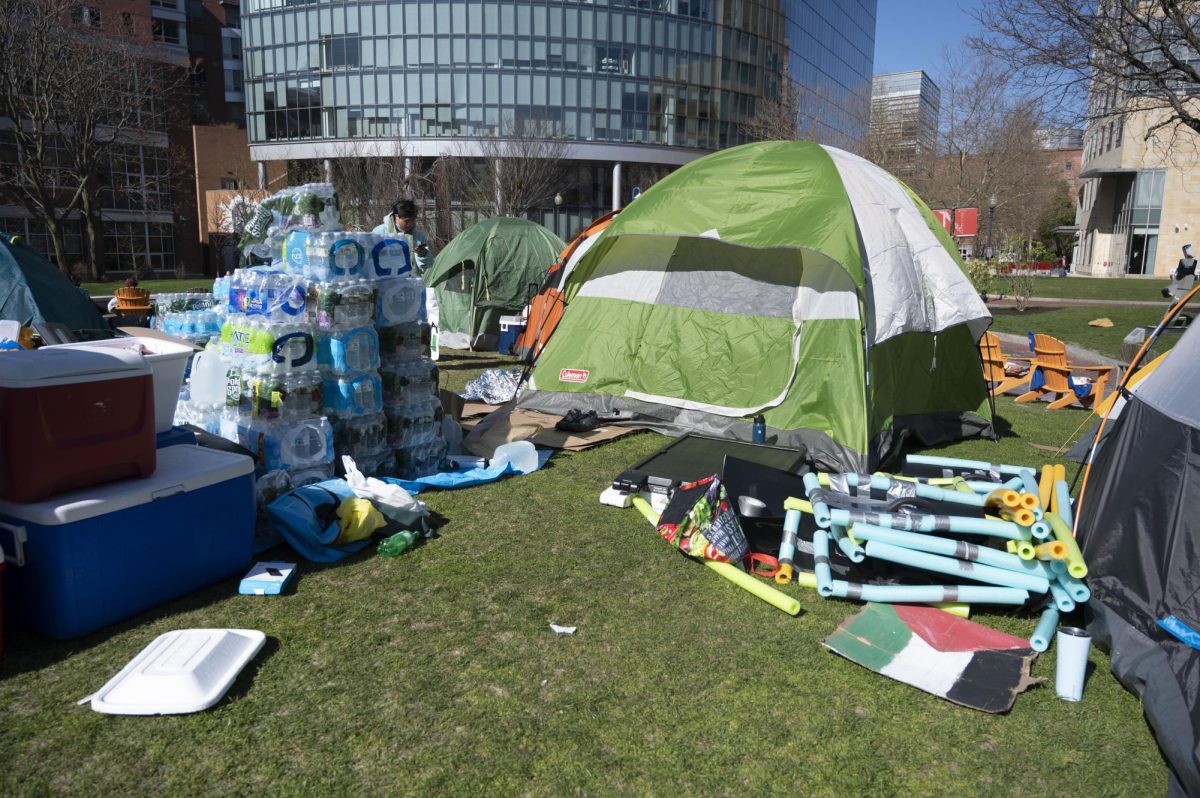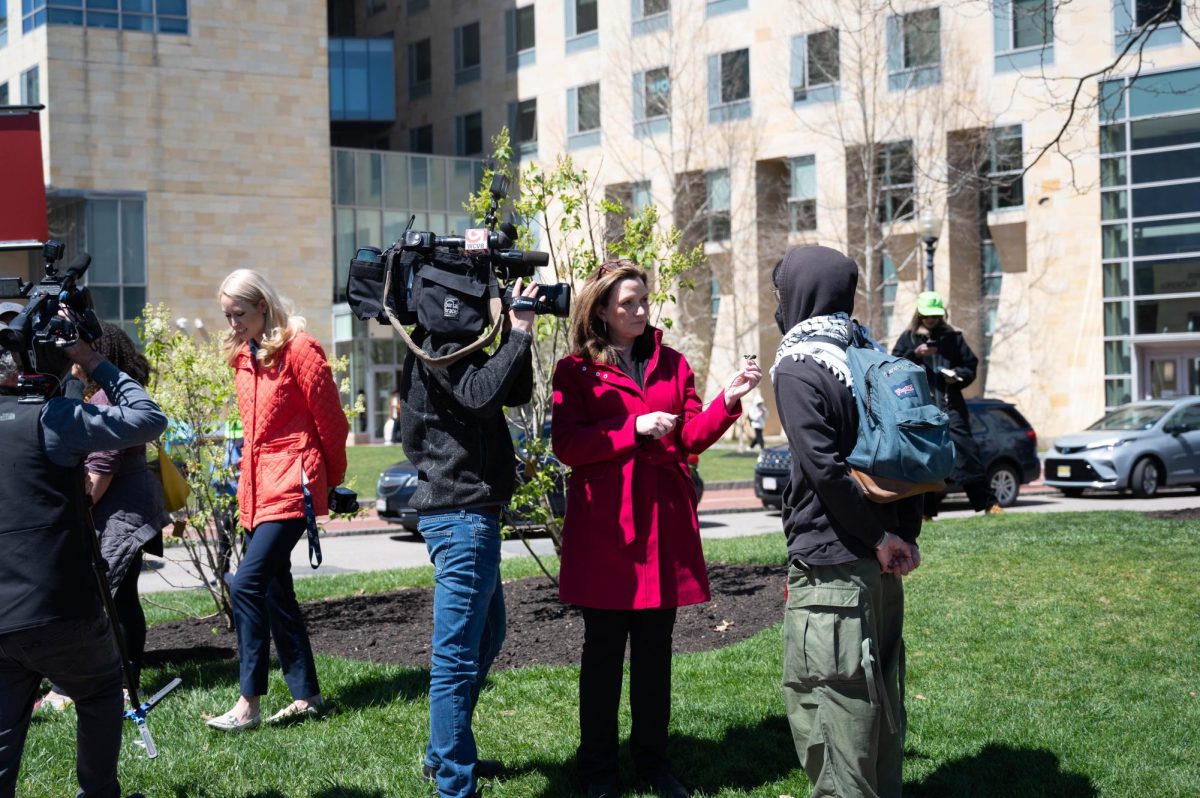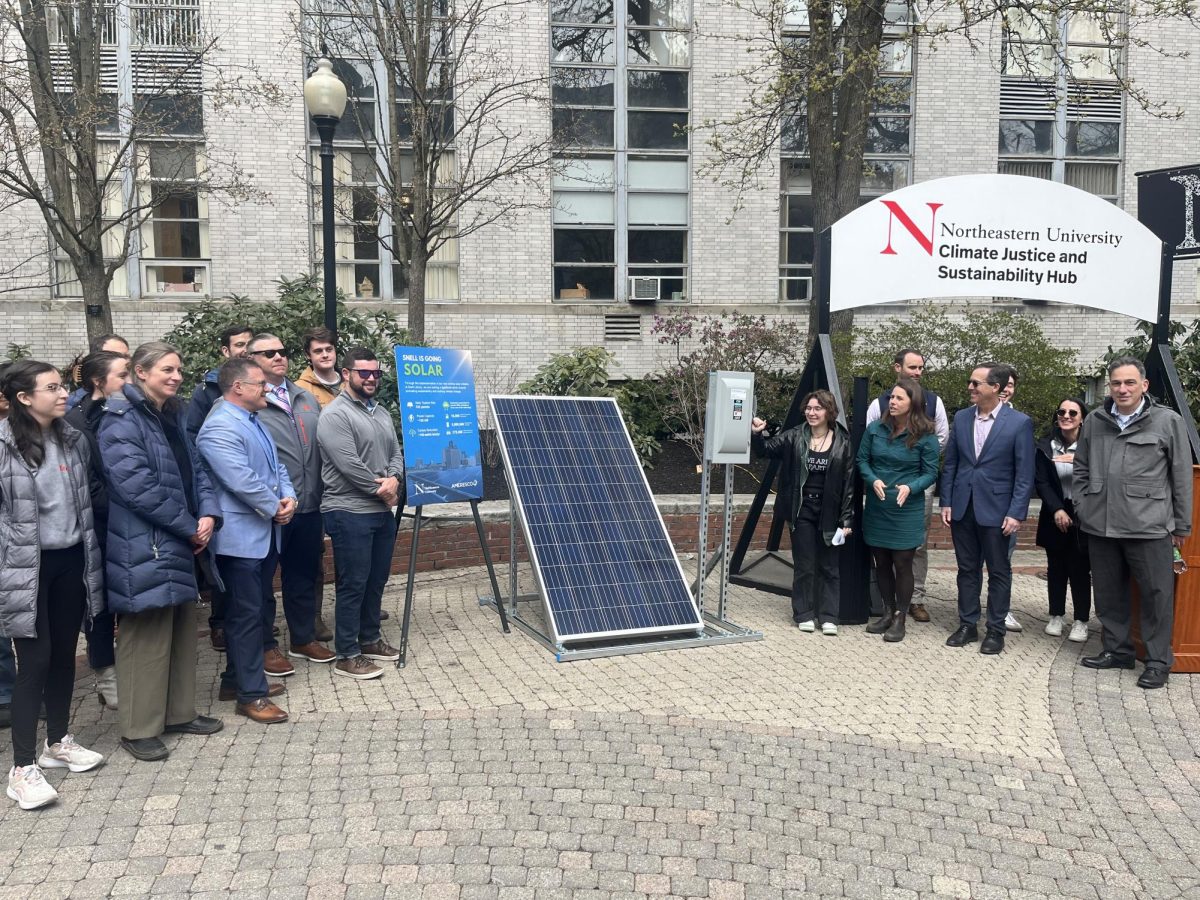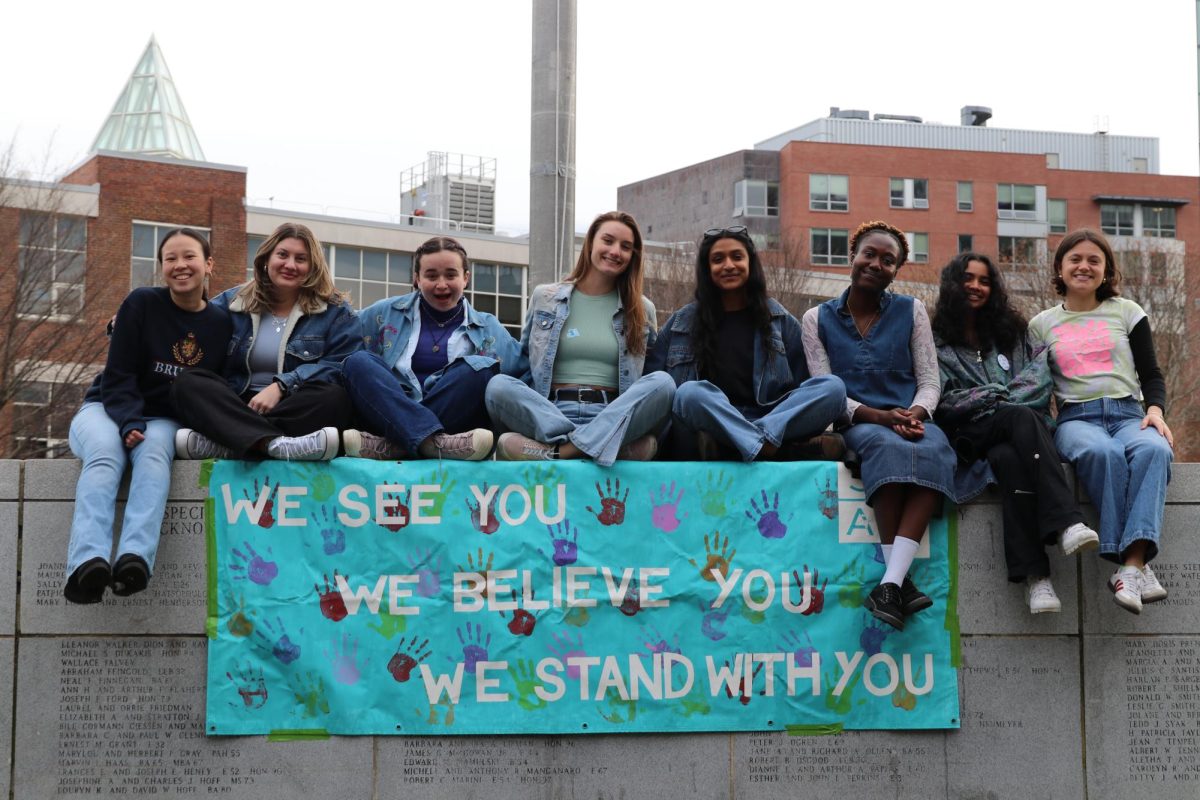By By Asha Pandya, News Correspondent
Nadia AlShammari twists her hair into a low bun on the back of her neck and ties it. She lays her scarf around her soon-to-be hidden hairline. AlShammari just exposed her hair in the girl’s locker room in the Marino Center, the one of few places on campus where men are not allowed to enter.
‘ AlShammari, originally from Saudi Arabia, is a practicing Muslim. The color, length and texture of her hair will remain undisclosed to the public.’ Apart from the man she will end up marrying, her female friends and relatives and her children, no one will ever be able to picture what she looks like without her headscarf.
‘ ‘Hair, along with everything else, is something that further defines your beauty,’ AlShammari said. ‘It’s not just covering your hair, it’s about being modest. A lot of times women are described as a jewel, or a precious stone, and you don’t want to just let her full beauty out to be seen by anyone. You want to save her.’
She demonstrated how to tie a hijab, a head covering worn by Muslim women. She started by wrapping her scarf around the edge of her head a couple of times.’
Without looking in the mirror, she tied her scarf in a tight knot underneath her right ear. Her style is not the traditional kind of wrap. Her hijab is wrapped around her head, but neck and ears remain exposed. She puts on her dangling earrings then whips the leftover material over her shoulder.’ ‘ ‘
‘It’s not just about this covering of the hair,’ said Mervat Hatem, a professor of political science at Howard University and the author of ‘Gender and Politics in the Middle East.’ ‘It is religious. Women wear hijabs because of their personal relationship with God. It’s also about dressing modestly because men and women are supposed to, sort of, maintain a distance from each other. It’s not just women, where the burden is to sort of avoid men. Men are supposed to avoid women as well.’
This social and physical distance might seem restrictive or overbearing to some non-Muslim college students, but many find the opposite to be true. One of the most common stereotypes about the Middle East highlights oppression of women, Hatem said. This stigma is most commonly associated with Arab women, but in reality, it affects the entire third-world, he said.’
‘I encourage my students to think of Muslim women as not that different from other women in the world,’ Hatem said. ‘They also want to gain education and lay the grounds for change. They want to expand their horizons and improve their gender roles in society too.’ ‘ ‘ ‘
At Northeastern, the majority of international female Arab students come from Saudi Arabia, according to the International Student and Scholar Institute (ISSI). These women have plan ned to get educated and experience life in the western world, then go home and become living examples of change.
‘I’m thinking of doing med school, but whatever happens I know I’m going to go back to Saudi,’ said Alshammari, a sophomore biochemistry and international affairs major. ‘I’ll either work in a hospital, open my own or possibly teach.’
AlShammari said her goal is to open her own local organization that helps society combat different problems, especially for women.
‘With my international affairs degree, I can start my own programs at home, and I can use my science field here to help others back in Saudi,’ she said.
Despite the discrimination AlShammari said she faces from some of her own people, she said she sticks strongly to her beliefs, and holds her lifestyle to the religious and cultural degree that she sees fit.
‘In Saudi someone can tell me even if I covered my neck and side of my face, that that is not enough. They might say I need to cover my face as well, and wear gloves too.’ What makes their standard what I should follow?’ she said. ‘What about what I believe?’
Arab women have been overcoming cultural obstacles and making their way through socio-political barriers throughout history. Stephanie Boyle, professor of women’s studies, emphasizes the history of women’s involvement in revolutionary and social movements in the Middle East, in her class ‘Third World Women.”
‘If you had to narrow it down, the most-talked about would be the’ Iranian Revolution (in 1979,) women in the first Palestinian Intifada (in 1988) and the removal of the veil in early 20th century Egypt,’ she said. ‘
Women all over the Middle East have actively led the political arena for centuries, Boyle said.’ ‘ ‘
‘You could ask, why do several Muslim countries have women as heads of state? Even long before Europe,’ said Leila Ahmed, a professor at Harvard University and author of ‘Women and Gender in Islam.’
These leaders, however, generally came from upper-class families.’
‘As far as social status goes, women who have more money dress more Western, travel more and speak more languages,’ Boyle said.
Social status and class vary, especially when considering a specific Middle Eastern country.
‘Arab women are always lumped into this huge category, and people need to remember that there are 22 Arab countries,’ Adley said. ‘It is important to account for national or class differences. Clearly different Arab women have different life experiences, especially depending on where they are, and how wealthy they are.”
In less urban regions of the Middle East, class still influences a woman’s accessibility to education.
Hatem said the women who come to the United States for an education go back and join ranks of educated and working women.
‘ ‘They challenge many of the conservative views of the rules and capabilities of women. So, in that respect, one can expect them to basically play a role in changing dominant views about women and their roles in society, Hatem said. Therefore, you can see them as part of the process of incremental change, as women have more access to education and develop the skills to gain more professional roles that were previously associated with men only.’
Hannah Allam, an Egyptian-American journalist and the Cairo Bureau Chief for McClatchy Newspapers, covers the entire Middle East and has been in almost every Arab state. Both the United States and’ the Middle East are home to her because of her father’s job in the oil industry. She has lived from Oklahoma to Saudi Arabia to Bahrain, to the United Arab Emirates and Iraq. Currently, she resides in Cairo and is a fellow at the Nieman foundation for journalism at Harvard University.’
‘I like to challenge stereotypes and shine a light on the region I cover,’ Allam said.’ ‘As an Arab-American Muslim woman, I also really take care not to commit the same errors that can perpetuate the misconceptions that have existed over time in the Muslim world.”
Allam said she believes the media has instilled false impressions about the Middle East in the western world.’
‘The perception is, and it’s reinforced by our media culture, that the entire Middle East is in flames, populated by women who are veiled and oppressed and men with guns strapped to them, and that is just not the truth,’ she said.’ ‘My mission is really to tell people what I see … I think of my readers as unsure travelers, so I want to show them what it is like, and just give them as many access points as possible.’
In February 2008, the King of Saudi Arabia, Abdullah Bin Abdul Aziz, appointed Noor Al-Fayez, a woman, as a new Supreme Court chief, minister of health, justice minister and information minister of Saudi Arabia.’
‘There have been so many improvements in the Saudi legal system. It’s crazy how everything is moving and changing so fast right now. We are actually seeing action, not just people talking,’ said Saja Kamal, a middler international affairs major at Northeastern. ‘In the past, women were hunting for jobs in neighboring countries because there was an influx of educated women who were not allowed to be employed. Someone must have said, ‘Hey, this is a problem,’ because now the government is sending out thousands of girls to go abroad and get their educations.”
‘ According to Saudi Arabias Ministry of foreign affairs, there more than 25,000 Saudi Arabian students receiving the governmental scholarship known as the College Preparatory Center scholarship (CPC), which is funded by the Saudi Aramco community.
‘Almost all of us are on this scholarship,’ Kamal said.’ ‘My friend is on the CPC one, they give her less budget, but as soon as she gets back to Saudi, she will work for them for five years.’ She is guaranteed a job.’
Kamal said she got a full scholarship from CPC and said the Saudi government has given a lot of opportunity to women who wish to study in the United States.
‘Now we don’t need our parents to pay for us, the government has our back,’ she said.’
Culturally, some women stray from their roots while others grasp them. In the workplace, tradition is put to the test for many Arab women.
‘Women who wear the hijab make a commitment, and that is not just connected to dress but also to connected to faith,’ Hatem said. ‘Those who wear it are not likely to drop it just because they come to the United States. I should make an exception to Saudi and Gulf women. Basically their state requires them to wear a particular mood of dress, a dark loose flowing overcoat called the abaaya. Some women when they are here take it off, and in this case it’s a question of the state requiring that mode of dress, it’s not really a question of faith.”
The opposite occurred in Kamal’s case.’
‘Back home I never used to wear hijab, and here I felt like I wanted to,’ Kamal said. ‘When people meet more girls who look like me, you really get to see that side of the Arab world that you don’t usually see, or something that is usually negatively seen. Even my dad was worried that the Muslims might perceive me in a wrong way or criticize me and say ‘she wears it wrong, or she wears a hoodie, she shows her neck,’ but I’m proud of my culture and I want to share it my own way.’
In the Arab world men also view the hijab in Islamic provisions.’
‘Men shouldn’t force a women to wear hijab,’ said Bandar Al-Saud, a Saudi Arabian and international affairs major at Northeastern.’ ‘They should have the niya, the faith, coming form within, to want to do it.’ It is between them and God.”
At Northeastern, these women have already taken the primary steps to making change both in America and at home.’
‘Ever since I came here, I was really glad because when I meet people from different cultures and religious backgrounds, that in itself is the most amazing experience,’ Kamal said. ‘It helps me further my goal of becoming an ambassador of Saudi Arabia or representing Saudi in any other country in the world.” ‘









